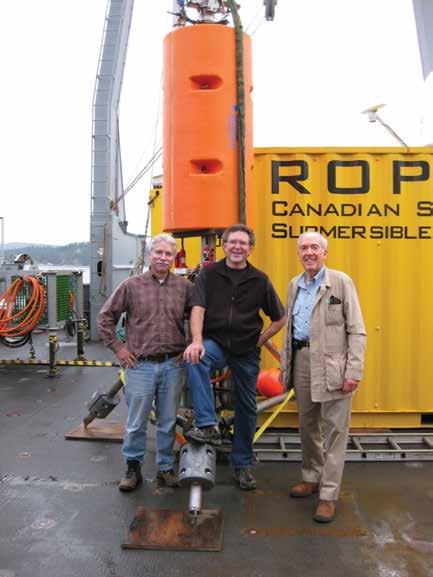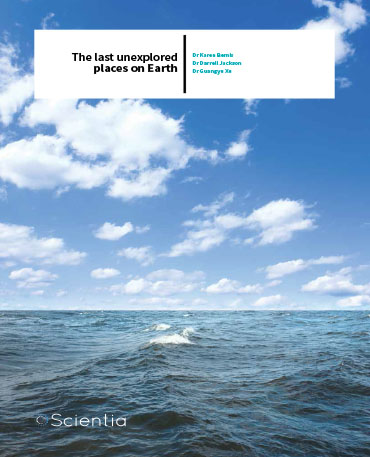Dr Karen Bemis, Dr Darrell Jackson, Dr Guangyu Xu – The Last Unexplored Places On Earth
A blind sighted look into the ocean depths
Deep down on the ocean floors, the Earth’s crust is formed at spreading centres, fissures populated with hydrothermal vents. As the name suggests, hydrothermal vents are hot places. There, water gets heated by the geothermal energy of the planet’s interior as a consequence of geological activity at the boundaries of plate tectonics, on mid-ocean ridges. The hydrothermal systems created by water circulating under the sea floor carry heat, chemical substances, microbes, and larvae out of the crust. The vents’ energy and heat are often exploited by deep sea creatures, who enjoy the microclimate. Often hydrothermal vents are in the form of ‘black smokers’. Black smokers emanate from chimney-shaped structures, formed of iron compounds precipitated as hydrothermal fluid mixes with much colder seawater. One quarter of the total heat lost by the Earth is eliminated through oceanic hydrothermal systems. In addition to black smokers, hydrothermal vents appear as a surprising variety of geological formations, such as flanges, mounds, beehive chimneys, patches and cracks. This activity is very difficult to observe directly due to poor visibility deep down. When it comes to measuring the heat output the buoyant plumes, the abyssal relief poses new challenges. Three researchers exploring all of these phenomena are Dr Karen Bemis, Dr Darrell Jackson, and Dr Guangyu Xu.

‘How the antifreeze glycoproteins, as well as other antifreeze proteins, evolved into functional antifreeze molecules is of much interest to evolutionary biologists’
Dr Bemis brings to the collaboration her cross-disciplinary knowledge of computer algorithms and geological phenomena occurring on the sea floor. She is interested in developing computer visualisations of changing geologic phenomena and gaining insight into fluid flow and heat transport in geologic processes. When asked what attracted her to the field, she explained: ‘I decided to study geology because I always liked rocks. As I got older, I became increasingly interested in why rocks differed, how they formed. In college, I focused on the physics of geologic processes. In graduate school, I started studying heat transfer related to hot springs at mid-oceanic ridges. This led me to underwater acoustics as a tool to study plumes of hot water from hot springs on the mid-oceanic ridges. Acoustic imaging has the advantage of both providing a 3D view of the plumes and their surroundings and of leading to quantitative measurements of fluid flow, volume flux and heat transfer.’
Dr Jackson contributes his skills and knowledge of signal processing techniques in underwater acoustics, and notably time-reversed acoustics. He tells us about how the trio came to work on oceanic hydrothermal systems. ‘Peter Rona noticed our work on using sonar to measure changes in seafloor temperature. He suggested that this technique could be applied to oceanic hydrothermal systems. Carefully designed sonar measurements can improve understanding of hydrothermal systems, much as ultrasound has improved medicine’s ability to observe the human body. Sonar provides a form of remote sensing, replacing a few point measurements with a 3D array of measured values.’ Peter Rona was an oceanographer with Rutgers University who found hot springs on the Mid-Atlantic Ridge in 1985 and is the founder of the collaboration.
Finally, Dr Xu brings his skills in scientific calculation and signal processing to the project. He is highly passionate about the underwater world and having ‘the opportunity to explore the many unknowns hidden beneath the surface of the ocean. Every day of my work is filled with the challenge of learning theories and skills and using them to better understand natural phenomena in the ocean. Deep-sea hydrothermal vents are important because they export heat and chemicals to the ocean and support unique benthic ecosystems. Our understanding of the ocean will remain incomplete without fully understanding hydrothermal vents’ impacts on and interactions with the ocean.’
COVIS is watching
The acoustic imaging of hydrothermal flow first started accidentally in 1984. Back then, a buoyant plume showed up on a routine sonar scan looking for obstacles in the path of ALVIN, a manned submarine. Later on, acoustic data processing and scientific visualisation were combined into new technologies capable of observing and quantifying what happens during hydrothermal discharges.
Drs Bemis and Jackson started making sonar observations to collect quantitative data on focused and diffuse hydrothermal flows. The project initially involved manned vehicles for deep sea exploration. However, those vehicles only allowed for an hour of exploration at a time. When they employed a Remotely Operated Vehicle (ROV), they could extend their periods of observation to a day in each session. Most recently, they, together with Dr Xu, made observations spanning years in a row by means of a sonar system connected to the NEPTUNE cabled observatory and operated by Ocean Networks Canada.
The Cabled Observatory Vent Imaging Sonar, or the COVIS, was developed with the help of the National Science Foundation. At its heart is the Reson SeaBat 7125 multi-beam sonar, capable of highresolution sonar imaging and giving the researchers a way to look into the abyss. In a paper titled ‘The path to COVIS: A review of acoustic imaging of hydrothermal flow regimes’, the team retraced the steps of scientific discovery from inception all the way to the development of leading-edge technology – the COVIS. Due to it being a cabled observatory residing almost permanently under the water, COVIS has monitored hydrothermal flows eight times a day for several years. Aided by the data the observatory sends back, the researchers were able to develop state-of-the-art diffuse flow detection techniques for estimating plume activity rhythms, bending, vertical rise, and volume and heat flux.

The importance of the research lies in two directions. ‘Heat transfer at mid-oceanic ridges is important for understanding the circulation of seawater-based fluids in the context of the plate tectonics system and from a climate perspective, for understanding the heat inputs of the ocean’, Dr Bemis explains. COVIS’ explorations started in 2010. Ever since then, its data have been used to create 3D dynamical images showing the effect of tides on the plumes, velocity measurements, heat transport estimates, and 2D images of spatial distributions of diffuse flows. But COVIS started with the question of whether acoustic imaging can really show the behaviour of the plumes. During the first five years of operations, up until 2015, COVIS performed excellent measurements and brought back a wealth of scientific knowledge. Just like bats,
COVIS sees through sound scattering and can take two-dimensional slices through the plumes, thus enabling the reconstruction of 3D images. The sonar can measure the velocity of the flows and shows the presence of diffuse hot water by detecting its shimmering effects like those of a hot roadway. COVIS can also be programmed and controlled remotely during its long missions.
The motion of plumes creates a Doppler shift in the frequency of the sonar echo, which helps determine the velocity of the water current. Together with 3D imaging, this shift helps determine the direction and strength of the current everywhere inside the plume. This is how the team made the striking discovery that the heat production can be larger than 10 megawatts, despite some plumes being thrown out of five holes, each with a size of only five centimetres. Around black smokers, the temperature reaches more than 250˚C, whereas the diffuse part of the plumes has temperatures of only a few tens of degrees. Researchers can see the diffuse flows by pointing the sonar to the ocean floor and programming the computer to listen to its ‘pings’. When diffuse flows are present, the sonar echo breaks its normal patterns and the result is transformed into maps of the flows.

Future plans and next steps
Cabled ocean observatories started a new era in oceanography. The data they produce reveal the interdependencies between geological, hydrothermal, oceanic, and biological processes. The mid-ocean ridge hydrothermal systems are especially interesting because of the larger implications they have for ocean ecosystems and climate.
The plans for this project are only beginning, now that the data have confirmed the possibility of investigating the hydrothermal flux by acoustic imaging. ‘We want to continue and expand this work into the US cabled observatory in the Eastern Pacific. Also, we hope to develop similar techniques for use on mobile platforms, ships and remotely-operated vehicles,’ Dr Jackson tells us. Dr Bemis adds that ‘having developed the COVIS and gained a great deal of understanding of plumes and the mechanisms of acoustic scattering by plumes, the next step is to develop an exploratory tool that would allow AUVs (autonomous underwater vehicles) and ships to identify plumes sourced from hot springs on mid-oceanic ridges as they survey the ocean floor’. Being a marine scientist, Dr Xu is interested in ‘exploring the far-reaching impacts of a deep-sea hydrothermal vent system on the ambient ocean. The targeting questions will be how the geochemical and biological matters are released from a hydrothermal vent site dispersed within the deep ocean and how far away from the vent site can they reach. How are those dispersal patterns driven by the ocean currents?’
Meet the researcher

Dr Karen Bemis
Department of Marine and Coastal Sciences Department of Earth and Planetary Sciences Rutgers University USA

Dr Darrell Jackson
Applied Physics Laboratory University of Washington USA

Dr Guangyu Xu
Woods Hole Oceanographic Institution USA Applied Physics Laboratory University of Washington USA
Dr Karen Bemis received her PhD in Geological Sciences at Rutgers in 1995 with work on morphology of volcanoes, especially small explosive volcanoes called cinder cones. In 1996, she continued to work with Peter Rona on hydrothermal systems as a postdoc at Rutgers where she was introduced to Deborah Silver and scientific visualization. Currently, she’s a Research Associate in the Department of Marine and Coastal Science at Rutgers. She continues to study cinder cones in Guatemala and sonar imaging of hydrothermal systems.
CONTACT
E: bemis@rutgers.edu
W: https://marine.rutgers.edu/main/kareng-bemis
Dr Darrell Jackson has two PhDs, one in electrical engineering and a second one in physics, from California Institute of Technology. He is a researcher and Research Professor Emeritus with the University of Washington Department of Electrical Engineering and a member of the Acoustical Society of America. His current research is focused on the application of multi-beam sonar to two different problems in acoustical oceanography: classification of the seafloor and observation of undersea hydrothermal vents. Past research has included signal processing techniques in underwater acoustics.
CONTACT
E: email: drj@apl.washington.edu
W: http://depts.washington.edu/aploa/darrell_jackson.html
Dr Guangyu Xu received his PhD in 2015 from Rutgers University is currently a researcher in marine sciences at the Marine Geology & Geophysics department of Woods Hole Oceanographic Institution. His research interests include the dynamics of deep-sea hydrothermal plumes and their interaction with ambient deep-sea currents and underlying geological processes. He already published a large number of research papers, held talks at multiple conferences and was engaged in teaching activities. He is proficient in scientific calculation and signal processing and enjoys fiction reading, swimming, and scuba diving in his little spare time remaining after his research activities.
CONTACT
KEY COLLABORATORS
Russ Light, APL-UW
Vern Miller, APL-UW
Michael Kenney, APL-UW
Anatoliy Ivakin, APL-UW
Deborah Silver, Rutgers
Christopher Jones, contractor
Eric Shug, Reson
Paul Jubinski, Reson
Mike Mutschler, Reson
Mairi Best, NEPTUNE CA
Lucie Pautet, NEPTUNE CA
Benoit Pirenne, NEPTUNE CA
FUNDING
US National Science Foundation






